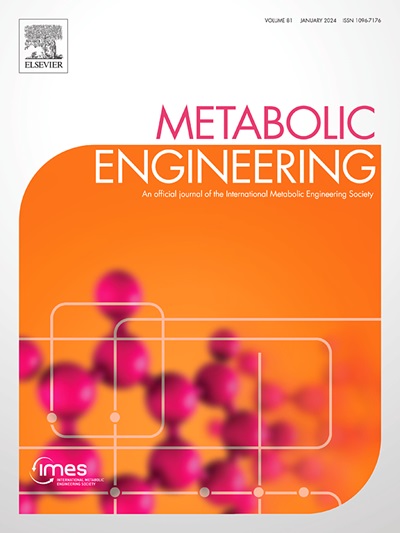Flux balance analysis and peptide mapping elucidate the impact of bioreactor pH on Chinese hamster ovary (CHO) cell metabolism and N-linked glycosylation in the fab and Fc regions of the produced IgG
IF 6.8
1区 生物学
Q1 BIOTECHNOLOGY & APPLIED MICROBIOLOGY
引用次数: 0
Abstract
Culture conditions have a profound impact on therapeutic protein production and glycosylation, a critical therapeutic-quality attribute, especially for monoclonal antibodies (mAbs). While the critical culture parameter of pH has been known since the early 1990s to affect protein glycosylation and production, detailed glycan and metabolic characterization and mechanistic understanding are critically lacking. Here, Chinese Hamster Ovary (CHO) cells were grown in bioreactors at pH 6.75, 7, and 7.25 (± 0.03) to examine how pH affects cell metabolism and site-specific N-linked glycosylation of the produced broadly neutralizing anti-HIV IgG1 mAb. VRC01 has N-linked glycosylation sites in both the Fc region and the Fab region, a situation not previously examined with respect to mAb glycosylation as affected by culture conditions. Using parsimonious Flux Balance Analysis (pFBA) and Flux Variability Analysis (FVA), we dissect and quantitate the impact of pH on cell growth, glucose/lactate metabolism, accumulation of the toxic metabolite ammonia, IgG production rates, and nonessential amino acid metabolism. pFBA revealed that beyond the established mechanism of glutamine conversion to glutamate, ammonia is also produced by the reaction converting serine to pyruvate, especially in the later phases of culture. pFBA also provided insights into the switch from ammonia production to consumption, notably due to depletion of glutamine, and consumption of glutamate and aspartate. We document that culture duration and pH alter the complex bimodal patterns (production/uptake) of several essential and non-essential amino acids. Site-specific N-linked glycan analysis using glycopeptide mapping demonstrated that pH significantly affects the glycosylation profiles of the two IgG1 sites. Fc region glycans were completely fucosylated but did not contain any sialylation. The Fab region glycans were not completely fucosylated but contained sialylated glycans. Bioreactor pH affected both the fucosylation and sialylation indexes in the Fab region and the galactosylation index of the Fc region. However, fucosylation in the Fc region was unaffected thus demonstrating that the effect of pH on site-specific N-linked glycosylation is complex.
通量平衡分析和肽图绘制阐明了生物反应器 pH 值对中国仓鼠卵巢(CHO)细胞新陈代谢和所产 IgG 的 Fab 和 Fc 区域中 N-连接糖基化的影响。
培养条件对治疗蛋白质的生产和糖基化有深远影响,而糖基化是治疗质量的关键属性,尤其是对单克隆抗体(mAbs)而言。虽然自 20 世纪 90 年代初以来人们就知道 pH 值这一关键培养参数会影响蛋白质糖基化和生产,但详细的糖基化和新陈代谢特征描述以及对机理的理解却非常缺乏。在这里,中国仓鼠卵巢(CHO)细胞在 pH 值为 6.75、7 和 7.25 的生物反应器中生长,以研究 pH 值如何影响细胞新陈代谢和所生产的广谱中和性抗艾滋病毒 IgG1 mAb 的特异位点 N-连接糖基化。VRC01的Fc区和Fab区都有N-连接的糖基化位点,这种情况是以前没有研究过的,即mAb糖基化受培养条件的影响。我们利用通量平衡分析(parsimonious Flux Balance Analysis,pFBA)和通量变异性分析(Flux Variability Analysis,FVA)剖析并量化了 pH 值对细胞生长、葡萄糖/乳酸代谢、毒性代谢产物氨的积累、IgG 生成率和非必需氨基酸代谢的影响。pFBA 发现,除了谷氨酰胺转化为谷氨酸的既定机制外,丝氨酸转化为丙酮酸的反应也会产生氨,尤其是在培养的后期阶段。我们发现,培养时间和 pH 值会改变几种必需氨基酸和非必需氨基酸的复杂双峰模式(产生/摄取)。利用糖肽图谱对特定位点的 N-连接聚糖进行分析表明,pH 值会显著影响两个 IgG1 位点的糖基化图谱。Fc 区的聚糖完全被岩藻糖基化,但不含任何硅烷基化。Fab 区的聚糖没有完全被岩藻糖基化,但含有硅烷基化聚糖。生物反应器的 pH 既影响 Fab 区的岩藻糖基化和硅烷基化指数,也影响 Fc 区的半乳糖基化指数。然而,Fc 区的岩藻糖基化不受影响,这表明 pH 值对特异位点 N-连接糖基化的影响是复杂的。
本文章由计算机程序翻译,如有差异,请以英文原文为准。
求助全文
约1分钟内获得全文
求助全文
来源期刊

Metabolic engineering
工程技术-生物工程与应用微生物
CiteScore
15.60
自引率
6.00%
发文量
140
审稿时长
44 days
期刊介绍:
Metabolic Engineering (MBE) is a journal that focuses on publishing original research papers on the directed modulation of metabolic pathways for metabolite overproduction or the enhancement of cellular properties. It welcomes papers that describe the engineering of native pathways and the synthesis of heterologous pathways to convert microorganisms into microbial cell factories. The journal covers experimental, computational, and modeling approaches for understanding metabolic pathways and manipulating them through genetic, media, or environmental means. Effective exploration of metabolic pathways necessitates the use of molecular biology and biochemistry methods, as well as engineering techniques for modeling and data analysis. MBE serves as a platform for interdisciplinary research in fields such as biochemistry, molecular biology, applied microbiology, cellular physiology, cellular nutrition in health and disease, and biochemical engineering. The journal publishes various types of papers, including original research papers and review papers. It is indexed and abstracted in databases such as Scopus, Embase, EMBiology, Current Contents - Life Sciences and Clinical Medicine, Science Citation Index, PubMed/Medline, CAS and Biotechnology Citation Index.
 求助内容:
求助内容: 应助结果提醒方式:
应助结果提醒方式:


